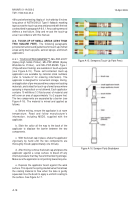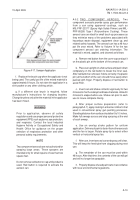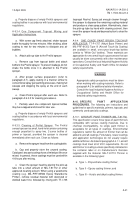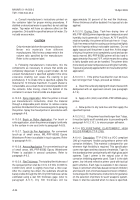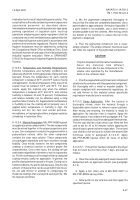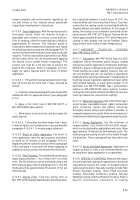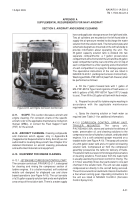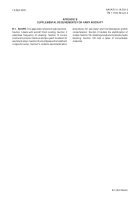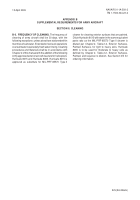TM-1-1500-344-23-2 - Page 198 of 240
A-28
NAVAIR 01-1A-509-2
TM 1-1500-344-23-2
15 April 2009
A-10.5.5.2. If the primer has dried longer than 7 days,
it must be lightly scuff sanded prior to proceeding with
paragraph A-10.5.5.1, to ensure proper adhesion.
A-10.5.6. Brush or Roller Application. For brush or
roller application, strain the topcoat per paragraph
A-10.5.5. Apply one uniform coat to the surface (refer to
paragraph A-8.5) and allow it to dry tack-free before
applying an additional coat (if needed) to achieve the
desired thickness.
A-10.5.7. Touch-Up Pen Application. For convenient
touch-up of small areas, MIL-PRF-85285 Polyurethane
Coating is available in touch-up pens. Refer to paragraph
A-9.1.
A-10.5.8. Aerosol Application. For convenient touch-up
of small areas less than two square feet, MIL-PRF-85285
Polyurethane Coating is available in aerosol containers.
Refer to paragraphs A-9.2 and A-9.3.
A-10.5.9. Film Thickness. The total dry film thickness of
MIL-PRF-85285 topcoat shall be 1.7 to 2.3 mils (0.0017
to 0.0023 inches). Dry film thickness can be estimated
using a wet film thickness gage (refer to paragraph
A-5.7). Dry film thickness will be approximately 50
percent of the wet film thickness.
A-10.5.10.
Drying Time. Tack-free drying time of
MIL-PRF-85285 topcoat depends upon the temperature,
but is approximately 4 hours at 70
°
F. Tack-free means
that the coating can be touched lightly with the fingertip
without noticeable tackiness. At this stage of drying, the
coating is not completely cured and can be easily
marred. The topcoat will dry hard in approximately 12
hours at 70
°
F, which means the coating is fairly durable
and can be handled. The coating dries more slowly at
lower temperatures. Complete coating system cure
requires approximately 7 days. In general, the aircraft
shall be handled and taxied as little as possible during
the first week after painting of exterior surfaces.
A-10.6. EPOXY
HIGH
SOLIDS
COATING
(MIL-PRF-22750).
A-10.6.1. Description. MIL-PRF-22750 epoxy topcoat
is a VOC compliant (340 g/l maximum) high solids
coating suitable as an alternate touch-up material when
polyurethane topcoats are not available or cannot be
used. This topcoat has excellent chemical resistance,
however, it is not as flexible as polyurethane topcoat
and will chalk when exposed to sunlight. Exact color
matching of epoxy topcoat to polyurethane topcoat is
usually poor and is aggravated by the tendency of
epoxy topcoat to chalk. MIL-PRF-22750 epoxy topcoat
can be applied over primers conforming to
MIL-PRF-23377, MIL-PRF-85582, and TT-P-2760.
A-10.6.2. Temperature Requirements. Ensure the
temperature for each coating component is between
60
°
F and 90
°
F before mixing and application. Surface
temperature of the area to be coated must be between
50
°
F and 95
°
F. Do not apply this material if the ambient
temperature is below 50
°
F.
A-10.6.3. Material Preparation. MIL-PRF-22750 topcoat
is supplied as a two component kit. The two components
must be mixed together in the proper proportions prior
to use. One component contains the pigment within an
epoxy vehicle, while the other component contains the
clear resin solution. These components are packaged
separately and have excellent storage stability. Once
mixed, however, the two components undergo a
chemical reaction to achieve proper film characteristics.
Over a few hours, the coating will gel and harden
regardless of whether or not it is exposed to air. Pot life
is a measure of the length of time a catalyzed coating
remains useful for application. In general, the pot life of
epoxy topcoat is 4 hours. During hot or humid conditions,
the pot life will decrease. Only mix the amount of
material that can be used within two hours. Do not add
thinner to attempt to compensate for thickened coatings
that are beyond useful pot life. Mix the topcoat as
follows:
a. Mix the pigmented component thoroughly to
ensure that the solids are completely dispersed. Use a
paint shaker for approximately 10 minutes if possible. If
a paint shaker is not available, use a clean metal or
wooden paddle to stir the contents. After mixing, check
the bottom of the container to ensure that all of the
pigment is dispersed.
b. Pour the pigmented component into a clean,
empty container. The empty container must be at least
two times the capacity of the pigmented component.
CAUTION
Only mix materials from the same manufacturer.
Never mix materials from different
manufacturers. Mix the two components in the
volume ratio specified by the manufacturer.
Refer to the container label.
c. Pour the required amount of clear resin component
slowly into the container with the pigmented component.
Stir thoroughly with a metal or wooden paddle. To
Back to Top

